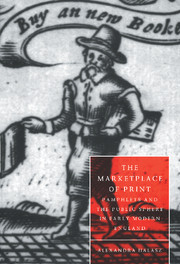2 - Figuring the marketplace of print
Published online by Cambridge University Press: 10 December 2009
Summary
In comes Chettle sweating and blowing, by reason of his fatnes, to welcome whom, because he was of olde acquaintance, all rose up, to drink a health to all the Lovers of Hellicon
Thomas Dekker, A Knight's Conjuring (1607)Controversies
Near the end of 1592 a pamphlet called Kind-Hartes Dreame appeared in London. It is fairly well known to literary historians because its preface defends Shakespeare's reputation against the charges made about him in Greenes Groatsworth of Wit. The pamphlet itself consists of five vignettes, each spoken by a distinct persona and offering topical comments appropriate to that persona, interspersed with a commentary presented by a sixth persona, Kind-hart. Two of the vignettes, one about ballad singing and one about playing, are often quoted in discussions of late sixteenth-century popular culture. But Kind-Hartes Dreame is more interesting than its current place in literary history would suggest, for it offers an insider's view of the effect of the book trade on the circulation of discourses. Its writer, Henry Chettle, was a Stationer who had spent some fifteen years as a member of the trade. After serving an apprenticeship, he worked as a journeyman compositor, briefly set up a print shop with two other men, and, if not by 1592, soon after, began writing for the stage even as he continued to work in the book trade. The preface to Kind-Hartes Dreame locates the pamphlet specifically in relation to current controversy about writing practices for the press and the stage. If, at the end of the sixteenth century, such writing took place under conditions of “polymorphous collaboration,” Chettle's pamphlet affords a compelling entry into the multiplicity of interests and positions involved in discursive production because Chettle himself occupied several of those positions.
- Type
- Chapter
- Information
- The Marketplace of PrintPamphlets and the Public Sphere in Early Modern England, pp. 46 - 81Publisher: Cambridge University PressPrint publication year: 1997



